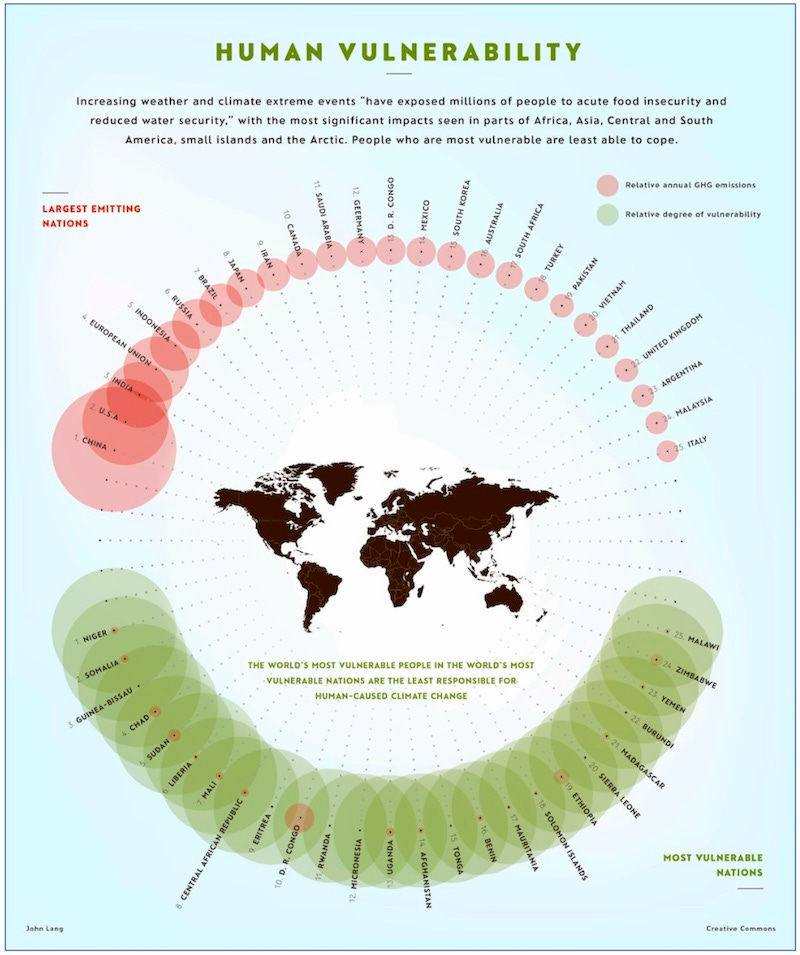The 2024 To-Do List: Climate Transition at a Fork in the Road
The fight against climate change is coming out of 2023 with something unusual and precious: momentum. Let’s make 2024 a year of good choices.
It’s been scarcely two weeks since the end of an intense year of non-stop climate news that was alarming and hopeful in more or less equal measures, bringing important, hard-fought advances that still weren’t enough to get a cascading global emergency under control.
2023 saw major momentum toward faster, deeper carbon cuts, even if there were very few clean, obvious wins. In a crisis that demands fast, decisive action, pretty much every step forward was more complicated and time-consuming than it should have been. And there were too many moments when looming climate tipping points and rampaging carbon emissions and fossil fuel production seemed too big to reverse.
But 2023 still brought us to a fork in the road on climate action and climate solutions, across Canada and around the world. As we ring in 2024, here are some of the big-picture stories that will solidify and accelerate last year’s gains—and the changes in narrative that will help us pick up the pace.
A ‘Crucial Inflection Point’
2023 wasn’t a total loss—not nearly—despite the many awful moments when it felt that way.
The year saw record heating and devastating local climate emergencies. And it may also have brought us to the “crucial inflection point” when global climate pollution begins to fall, while emissions in China enter a permanent, structural decline.
Countries attending the COP28 climate summit called for a transition out of fossil fuels and pledged to triple renewable energy capacity and double the pace of annual energy efficiency improvements. Then oil and gas CEOs—including COP28 President Sultan Al Jaber, CEO of the Abu Dhabi National Oil Company—made clear they would continue expanding their operations.
The COP finally, finally agreed on an historic framework to address the irreversible loss and damage that vulnerable communities already face as a result of runaway climate change. But by the end of the conference, the loss and damage fund was still desperately underfunded, and small island states that might have raised that and other objections to the self-styled “UAE Consensus” were out of the room when the final decision was gavelled.
New governments in Brazil and Poland recommitted to climate action, while new governments in Argentina and New Zealand along with the current incumbents in the United Kingdom seemed intent on rolling it back. (The UK is due for national elections in the second half of this year, and at last count hapless Prime Minister Rishi Sunak was running about 20 points behind in opinion polls.)
In Canada, a flurry of new tax credits and regulatory announcements had the federal government closing in on its 2030 emissions reduction target, and a few megatonnes ahead of its interim goal for 2026. And there was no federal program too small, no decision or announcement too routine, for the Alberta and Saskatchewan governments to reflexively hate it.
Ottawa’s late October decision to suspend carbon tax payments on home heating oil and expand heat pump incentives in Atlantic Canada drew howls of protest from usual suspects like Premiers Danielle Smith and Scott Moe. And the announcement spurred thoughtful, important discussions on how to bring energy affordability to the centre of Canadian climate policy—and how to design a carbon tax that voters can love.
The Fork in the Road
All of these continuing stories, and so many others, show how the decisions we make on climate change and climate solutions permeate every aspect of everyday life, from energy choices at home to global geopolitics, for better and for worse. This is what it feels like to be at a fork in the road, where competing agendas and narratives simultaneously create a fog of confusion and a wealth of possibilities.
Here are some of the areas where the right choices can deliver solid progress in 2024.
Climate Finance
It’ll cost trillions of dollars per year to get the climate transition done. But that’s still far less than the overwhelming economic and human cost of letting the climate emergency spin out of control.
Annual clean energy investment now routinely exceeds the new money pouring into fossil fuel expansion. But the fact that fossil industries still get any new investment at all, when their business plans already far exceed the available global carbon budget, is all the evidence you need that a fork in the road is not a place we can safely stay.
In 2024, the dollars need to flow—from the local to the international levels, and from government agencies, private investors, multilateral agencies, and philanthropies. Governments everywhere need to get moving on financial sector regulations like Sen. Rosa Galvez’ Climate-Aligned Finance Act—because big banks in Canada and elsewhere aren’t moving nearly fast enough to disclose and reduce their financed emissions. And it’s as urgent as ever to clear the bureaucratic hurdles to international climate finance that prevent the world’s most vulnerable countries from getting the timely investment they need.
The Phasedown
It’ll take time to complete the shift off carbon, and no one is seriously suggesting that we can phase out all oil, gas, and coal overnight. But with the International Energy Agency and a growing chorus of independent modellers and forecasters projecting a steady decline in fossil fuel demand—often for reasons that are only adjacent to climate change and decarbonization—there’s no rational or sane argument to increase exploration, development, or production.
Continuing the push for fossil fuel expansion is a recipe for economic disruption and job loss when today’s shiny, new project pitches become tomorrow’s stranded assets. The time, effort, and money now going into new fossil project development can and must be diverted to clean energy investments—and to job transition strategies that work from the ground up, build on communities’ strengths, and start out with a promise to leave no one behind.
Scaling Up and Making Good Choices
The mind-boggling pace of renewable energy and energy efficiency deployment has been one of the good news stories of the early 2020s. Now we need that activity to scale up. Often, that will mean addressing larger issues that can create insurmountable obstacles to local projects—like supply chain snags and high interest rates that destroy the business case for an offshore wind farm, utility grid bottlenecks that are impeding gigawatts of new, clean electricity in the United States, or nakedly political obstruction like Alberta’s senseless, seven-month moratorium on renewable energy development.
Scaling up fast isn’t the same as doing it indiscriminately. Making good choices can and should begin with picking the projects and technologies that can deliver the biggest emission reductions in the shortest time at the lowest cost. That simple, common sense standard would point you directly to energy efficiency, solar, wind, and methane controls in the fossil fuel industry, the Intergovernmental Panel on Climate Change reported last year. Small modular nuclear reactors and industrial carbon and capture deliver the least bang for the buck, the IPCC found.
Making good choices also means working with the people who were on the ground in local communities before project proponents brought their glossy PowerPoints to town. There are no saints in climate and energy work, and too many renewable energy developers have bought themselves too much needless opposition and delay by not stopping to listen. (Pro tip: If you’re working in an Acadian region in New Brunswick, don’t expect it to end well if you’re trying to communicate in English only.) Indigenous Clean Energy is a great place to learn about successful renewable energy projects that are built to serve community needs and goals.
Telling the Right Story
The fossil industry continues to invest lavishly to build the dangerous narrative that natural gas, in particular, is a necessary part of our energy future, not a methane bomb that needs to be phased down and out. Climate organizations and clean energy industries won’t be able to outspend them anytime soon—which is why campaign groups are making such an important contribution by challenging the industry’s false advertising and calling out ad agencies that help fossils get their word out.
In 2024, we’ll need a bigger, wider effort to get the story right:
That the climate and energy transition is about opportunity and gain, not loss and pain.
That those words mean different things, depending on where you live—so investment is needed most in communities and countries where unimaginable loss and pain are already the everyday reality.
That dollars devoted to the shift off carbon are an investment, not a sacrifice.
That there’s just one realistic route to affordable energy for all and a revolution in energy jobs. And that route won’t likely pass through the coffers or the business plan of the nearest fossil fuel company.
That anyone involved in this work should be ready and eager to build partnerships, to err on the side of having too many friends and not enough enemies—as long as those allies are genuinely ready to work from a position of substance, not greenwash.
That climate analysts and advocates (and, cough cough, climate publishers) shouldn’t be afraid to celebrate good news and take the wins when we can, to whatever extent we can, as long as we’re diligently following the evidence where it leads.
None of this will happen overnight, and none of it will be easy. But the ups and downs of 2023 have left us with good momentum, possibly more than we’ve ever seen before. We’re still in a global emergency, and this is not the way any of us should have wanted to start the year. But it’s what we’ve got, and the good news is that we’re starting out with so many strengths and positives to build on.
Mitchell Beer traces his background in renewable energy and energy efficiency back to 1977, in climate change to 1997. Now he and the rest of the Energy Mix team scan 1,200 news headlines a week to pull together The Energy Mix, The Energy Mix Weekender, and our weekly feature digests, Cities & Communities and Heat & Power.
Chart of the Week
U.S. Judge Sends Landmark Youth Climate Case to Trial
Solid-State Battery Breakthrough Could Double EV Range
Oil Producers ‘Disappointed’ as Trans Mountain Pipeline Nears Completion
$30.9B Price Tag Makes Trans Mountain Pipeline a ‘Catastrophic Boondoggle’
Failed U.S. Nuclear Project Raised Cost Concerns for Canadian SMR Development
‘This Blows My Mind’, Critic Said, after CCS Centre Admitted It Won’t Meet 2035 Deadline
Big Batteries Likely Powered by High-Emitting Gas Under Ontario Grid Plan
Fossil Companies Face $50B Lawsuit Over 2021 Heat Dome Deaths
Is Canada on track to its 2030 target? (440 Megatonnes/Canadian Climate Institute)
Renewable energy’s share on German power grids reached 55% in 2023 (Reuters)
UK electricity from fossil fuels drops to lowest level since 1957(Carbon Brief)
Just sensible investment': Keir Starmer holds firm on £28B/year green spending goal (Business Green)
US Becomes Top LNG Exporter After Overtaking Australia and Qatar (Bloomberg)
China Regains Top LNG Buyer Position (Rigzone)
Exxon crashes COP28 to ‘fight for its life’ (ExxonKnews)
How Russia won a 'dangerous loophole' for fossil gas at COP28 (Climate Home News)
Azerbaijan appoints state oil company veteran as COP29 president (Climate Home News)
TVA may delay 2,470-MW coal plant shutdown over FERC pipeline inaction (Utility Dive)
Using waste heat from PV panels to generate residential hot water (PV Magazine)








